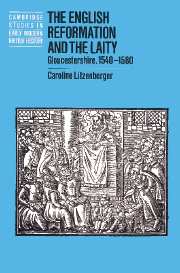Book contents
- Frontmatter
- Contents
- List of figures
- List of tables
- Acknowledgments
- Abbreviations and conventions
- Introduction
- 1 Setting the scene
- 2 Gloucestershire in the 1530s
- 3 The new diocese of Gloucester (1540–1546)
- 4 The advent of Edwardian Protestantism (1547–1553)
- 5 A return to the old religion (1553–1558)
- 6 The early years of Elizabeth's reign (1559–1569)
- 7 The clarification of the religious settlement (1570–1580)
- Conclusion
- Appendix A Sources and methodology
- Appendix B Results of wills analysis
- Appendix C Parish finances
- Bibliography
- Index
- Cambridge Studies in Early Modern British History
1 - Setting the scene
Published online by Cambridge University Press: 23 November 2009
- Frontmatter
- Contents
- List of figures
- List of tables
- Acknowledgments
- Abbreviations and conventions
- Introduction
- 1 Setting the scene
- 2 Gloucestershire in the 1530s
- 3 The new diocese of Gloucester (1540–1546)
- 4 The advent of Edwardian Protestantism (1547–1553)
- 5 A return to the old religion (1553–1558)
- 6 The early years of Elizabeth's reign (1559–1569)
- 7 The clarification of the religious settlement (1570–1580)
- Conclusion
- Appendix A Sources and methodology
- Appendix B Results of wills analysis
- Appendix C Parish finances
- Bibliography
- Index
- Cambridge Studies in Early Modern British History
Summary
As a part of the process of ecclesiastical change in the early 1540s, a number of new dioceses were founded. The old diocesan structure had included the huge dioceses of Lincoln and York, as well as other only slightly more manageable sees such as Worcester. In the space of two years after the dissolution of the monasteries, six new dioceses were carved out of the larger sees and endowed with previous monastic holdings: Bristol, Chester, Oxford, Peterborough, Westminster and Gloucester. Bristol was created a year after the others, from portions of Bath and Wells, Salisbury and Gloucester. Both Oxford and Peterborough had been archdeaconries in the diocese of Lincoln. Westminster, which was a diocese for only ten years, was part of the diocese of London both before and after its separate existence. Chester was created out of Lichfield and York. The diocese of Gloucester, most of which had been a deanery in the diocese of Worcester, was established by letters patent on 3 September 1541. The new diocese was nearly contiguous with Gloucestershire. The abbey church of the former monastery of St Peter, Gloucester, became the cathedral, and the former home of the abbot became the bishop's palace.
The geography of the county and diocese of Gloucester was distinctive and varied, and influenced both politics and religion. It is bounded on the west by the Forest of Dean, while on the east, green hillsides cut by narrow valleys and fast-flowing streams rise sharply from the valley floor toward the undulating hills of the Cotswolds. In between lies the flat, fertile Vale of the Severn, with its shimmering river twisting gradually out of sight to the south-west like a silver ribbon.
- Type
- Chapter
- Information
- The English Reformation and the LaityGloucestershire, 1540–1580, pp. 9 - 22Publisher: Cambridge University PressPrint publication year: 1997



